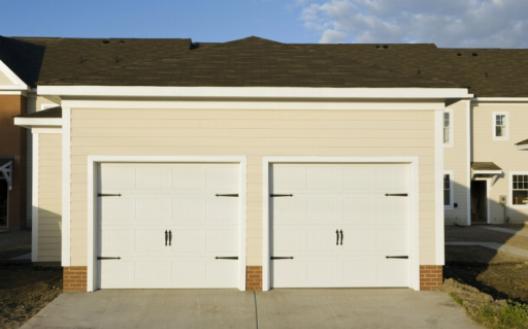The Ultimate Guide to Garage Door Panel Replacement: Everything You Need to Know
22 November 2025 by Zuzanna H.Garage doors play a crucial role in the functionality and aesthetics of a modern home. Over time, wear and tear can cause damage to the panels, requiring a replacement to restore the door's functionality and appearance. Understanding the process of garage door panel replacement is essential for homeowners looking to tackle this DIY project. From selecting the right panels to troubleshooting common issues after replacement, this ultimate guide provides everything you need to know about garage door panel replacement.

Understanding Garage Door Panel Damage and Replacement Needs
Garage door panels are an essential element of the overall structure of a garage door, providing both functional and aesthetic benefits. Over time, these panels can become damaged due to various reasons such as accidents, weather conditions, or general wear and tear. Understanding the signs of garage door panel damage is crucial in determining the need for replacement. Common signs of garage door panel damage include dents, cracks, warping, and rust. Dents can occur due to accidental impacts from vehicles or other objects, while cracks may develop from prolonged exposure to extreme temperatures or physical damage. Warping can occur over time as a result of sun exposure and changes in humidity, leading to misalignment and difficulties in opening and closing the door. Rust is another common issue, especially in older metal garage door panels, and can compromise the structural integrity of the door. It is important to address garage door panel damage promptly to prevent further issues and ensure the safety and security of your home. Additionally, damaged panels can affect the insulation and energy efficiency of the garage, leading to increased energy costs. Once you have identified the signs of garage door panel damage, it is essential to assess the extent of the damage and determine whether panel replacement is necessary. In some cases, minor dents or cracks can be repaired, but significant damage may require the replacement of entire panels. Taking the time to understand garage door panel damage and replacement needs is the first step in ensuring the longevity and functionality of your garage door. By promptly addressing any issues and considering the best course of action for panel replacement, you can maintain the safety, security, and aesthetic appeal of your home.Choosing the Right Panels for Your Garage Door
When it comes to choosing the right panels for your garage door, there are several factors to consider. The first thing to take into account is the material of the panels. Common materials for garage door panels include steel, aluminum, wood, and fiberglass. Each material has its own advantages and disadvantages, so it's important to assess your needs and preferences before making a decision. Steel panels are popular for their durability and low maintenance requirements. They can also provide insulation for your garage, which can help regulate temperature and reduce energy costs. Aluminum panels are lightweight and resistant to rust, making them a good option for coastal or humid environments. Wood panels add a touch of elegance to your home and can be customized to match your existing exterior, but they do require more maintenance. Fiberglass panels are a low-maintenance option that can mimic the look of wood without the upkeep. In addition to material, you'll also need to consider the style and design of the panels. Garage door panels come in a variety of patterns, textures, and colors, so you can choose a style that complements the overall aesthetic of your home. You may also want to consider the insulation properties of the panels, especially if your garage is attached to your home or if you spend time in the garage. Before making a decision, it's a good idea to consult with a professional to determine the best panels for your specific garage door. They can provide recommendations based on your needs, budget, and design preferences. Keep in mind that replacing garage door panels is a significant investment, so it's important to choose panels that will enhance the functionality and curb appeal of your home for years to come.Step-by-Step Guide to Replacing Garage Door Panels
Replacing garage door panels can be a daunting task, but with the right tools and knowledge, it can be done successfully. Here is a step-by-step guide to help you tackle this DIY project:1. Gather the necessary tools and materials. This may include a screwdriver, pliers, hammer, replacement panels, and safety equipment such as gloves and eye protection.
2. Inspect the damage. Before starting the replacement, thoroughly inspect the garage door panels to determine the extent of the damage and to identify any other issues that may need attention.
3. Measure and order replacement panels. Take accurate measurements of the damaged panels and order the appropriate replacement panels from a reputable supplier.
4. Prepare the work area. Clear the area around the garage door and ensure that it is well-lit and free of any obstructions.
5. Remove the old panels. Start by disconnecting the garage door opener and carefully remove the damaged panels, paying close attention to any hardware or fasteners that may need to be removed.
6. Install the new panels. Follow the manufacturer's instructions to properly install the replacement panels, making sure to align them correctly and secure them in place.
7. Reconnect the garage door opener. Once the new panels are in place, reconnect the garage door opener and test the door to ensure that it is functioning properly.
8. Inspect and make any necessary adjustments. Take the time to inspect the entire door and make any necessary adjustments to ensure that it is operating smoothly and safely.
9. Clean up and dispose of the old panels. Dispose of the old panels properly and clean up the work area to complete the project. By following these steps and taking the time to do the job right, you can successfully replace garage door panels and restore the functionality and appearance of your garage door.